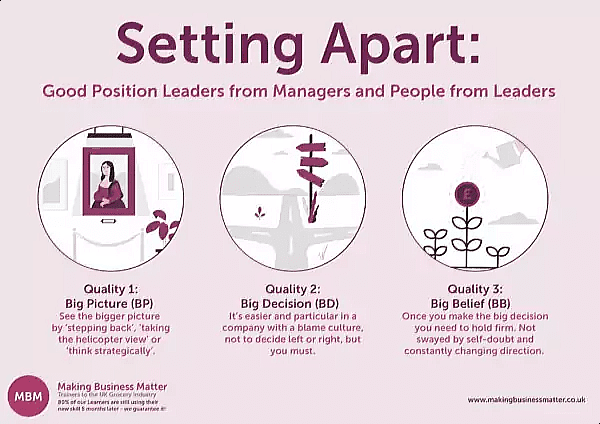We debated this very issue recently in a team meeting – What is the Difference Between Leadership and Management?
As soft skills trainers, you’d expect us to have the answer to the difference between leadership and management. We do. Just not the same answer. Not yet, anyway – read on…
Our debate ensued with perspectives around leadership and managerial qualities. One person said that a leader inspires. Then, another person said that managers should inspire too. An uninspiring manager is not someone you’d want to work for.
Someone else chimed in, ‘People follow leaders. Managers ‘just’ have people that work for them’. The counterargument came across, ‘Employees leave bad bosses and your perspective is about whether people want to work for someone or not. Which is not a leader/manager debate. It’s a, do I want to work for them debate. ‘Follow’ is semantics’.
‘Leaders set an example’, and then he quickly realised what he’d said, and followed up with, ‘But both leaders and managers should set examples’. Quickly hijacked by another who said, ‘Leaders take risks’. She said confidently and awaited the challenge. It came, ‘Everyone takes risks. Every level. It’s about the level of risk’.
Listening quietly throughout, another eagerly and assertively then said, ‘That’s it. You’ve got it. It’s about ‘levels’. Not in the traditional sense, although that does separate people to some extent – A director is a leader and a manager is management. It’s about the bigger picture. What they see. The levels’. The group were reflecting and nodding at the same time.
‘Levels’ was the Start of Forming our Answer to the Question – What is the Difference Between Leadership and Management?

Before we share our conclusion, let’s put your mind at rest (And ours!). The terms leadership and management are often interchanged.
We hear ‘leaders’ and immediately think of CEOs, entrepreneurs, and innovators, like Elon Musk, Richard Branson and Sir Alan Sugar. They are leaders and very successful in leading companies to success. But what about leaders at your work? You normally think of your Directors and they are also leaders, but let’s not forget those people that lead even though they are ‘just’ a manager. I bet you can name at least one that you admire.
Our answer is that leaders can be at any level. Yes, that sounds a little twee, like when everyone wins at the school races. No, we don’t mean that. We mean that everyone can lead. Let me explain…
Leaders look up and survey the situation from higher ground. They take a ‘helicopter view’ and decide whether the current plan will achieve its goals. And, if the current plan is unlikely to achieve its goals they change the approach and instruct others accordingly.
For Example:
- James Dyson surveyed the vacuum cleaner market and decided that a better cleaner could be made. He did not lead anyone at that point. Only himself and his own thinking.
- A person on the beach has no team, no reports, and they do not manage. They are just a human being. Yet they pick up their rubbish, pick up the rubbish of others, even if it is not theirs, and put it all in the bin. Others then follow their example. The Japanese fans at the football World Cup did the same.
- In 1971 Frank Serpico was a New York City police officer who blew the whistle on fellow officers that were taking bribes. His testimony started a widespread investigation into Police corruption in NYC.
Leaders don’t need to be given a position to lead.
Yes, there are leaders by position. CEOs, Directors and alike, are leaders because of their position (Though many can have the position of leader and be a very bad leader). Positional leaders see more than anyone else because they are at the top of the tree and their job is to use that privileged position to ‘survey the land’ and make course adjustments if targets aren’t likely to be achieved. There are also leaders who have not been give a position.
I Disagree with Harvard Business Review on the Difference Between Leadership and Management
In this article, HBR says that ‘Leadership refers to an individual’s ability to influence, motivate, and enable others to contribute toward organisational success. Influence and inspiration separate leaders from managers, not power and control.’
I disagree.
Managers need to influence, motivate, and contribute also. These abilities is not what sets leaders and managers apart. We might believe that leaders do more of it, but that’s a similar argument to the government suggesting that crime is reducing. That’s true, crime might be reduced, according to the statistics. But what about if the Police are just catching fewer criminals? The statistics would also show that crime was reducing. We believe that we and others are more inspired by position leaders because no one looks at managers and measures how much they inspire us.
Sticky Learning ® is 7 times more effective than 1-day training courses. Plus, you will get a Chain of Evidence proving your Return on Investment. Discover soft skills training that changes behaviours long term.

Brian Tracy Shares the Answer to the Leadership & Management Question But it’s Too Complicated
I watched this 8-minute video from Brian Tracy answering the question of ‘What is the Difference Between Leadership and Management?’. By the way his ‘Eat That Frog‘ book changed my life, so I am a big fan of his. Yet, from his video, I came away even more confused. His points were about overlap, the interchangeability, which I agree with, though I got lost in the qualities of each. I think I counted over 30 qualities needed by one or the other or both leader and manager.
We need a better, simpler and easier-to-implement answer to the question that has plagued ‘management’ for decades – What’s the difference between leadership and management?
I hope that through this article you will discover a simple and implementable answer. Certainly, if you skip to the summary below we’ll give that to you. You may agree, or disagree, but at least you have a simple takeaway that you can use.
The 2 Types of Leaders

1. Position Leaders (Leaders by Position)
They have the ‘badge’ of Director and they then should lead. Having that position does not mean that they do lead. Yes, they’ll be authorised to see more information and be party to more of what is going on, but that does not mean that they are a good leader.
Bad Position leaders
We’ve all seen bad position leaders. They use their seniority to bully, avoid making decisions, and blame management for not making the plan work. I once worked for a Director that was forever fiddling with ‘my business’. I was a Category Manager and he was forever telling me what we should do to sell more of my products. He added very little. Plus, if I were to have asked him, ‘Where is our 3-year strategy?’, he didn’t have one. It was easier for him to try and do my job than to do his own.
Good Position Leaders
They use their position of being able to see across the whole company to make course corrections, foresee problems & avoid those problems happening, and share the belief that what they want to achieve as a business is possible.
2. Self-Appointed Leaders (Leaders by Choice)
The guy on the beach, James Dyson, and Mr Serpico are self-appointed leaders. No one asked them to. They chose to lead, to set an example, where they could have just as easily not chosen to do so.
Anyone can lead. In business, you are much more easily able to lead if you have the position. Without the position, it’s harder, but still possible. A little like basketball. At over 7 feet you can probably play basketball at least averagely well due to your height advantage. At 6 feet you’ll need to try harder just to be average.
Leaders are Separated from Managers by 3 Qualities

Quality #1: Big Picture (BP)
It used to be known as ‘Strategic Thinking‘. Though no one ever quite understood what that meant. This quality is the ability to see the bigger picture, either because of your level – position leader or because you want to – maybe as a manager. Taking the Helicopter view. Or creating the bigger picture for others to follow.
Ray Kroc, the founder of McDonald’s, wanted to create a consistent burger. That was his vision and he worked tirelessly towards it and demanded that others did too. Leaders set the vision and others make it happen.
Quality #2: Big Decisions (BD)
It’s no use seeing the bigger picture if you can’t or won’t make a decision. The courage to make decisions about what the vision is and how it is achieved, and to accept the consequences, good or bad, is what makes a leader. Managers don’t make the high-level decisions because their job is to deliver what is needed, not to decide what is needed at a high level. Managers manage and Directors direct.
Quality #3: Big Belief (BB)
Imagine if every failure had James Dyson questioning what he was doing to the point where he couldn’t move forward. Dyson wouldn’t be outselling Hoover 4:1 in the UK. Imagine if Anita Roddick (Body Shop Founder) was blown off course by every knockback, she wouldn’t have had 3,000 stores in 65 countries.
Once you make the big decisions you need to stay with those decisions and most importantly not show your constant self-doubt to your team. Your team needs to be assured that this is the right direction, you chose it, and it will work. If they believe that you believe it will not work, they won’t believe either and then it will not deliver.
The M&S Example
M&S decided on the Plan B sustainability initiative (BD). The leaders believed that this was what the company needed to do (BB). Whether they were right or wrong, they surveyed the land from a high level (BP) and made a decision that this was what the company needs to achieve. The job of the managers was then to deliver on that vision.
An MBM Example
I made a decision (BD) some years ago that Search Engine Optimisation was key to MBM’s success. I decided this because HR Managers were only going to search for, e.g. ‘time management training course‘ more than they already did (BP). It was the future and it was here to stay.
Many a time in the last 7 years I have wobbled on that decision because we have spent a huge amount of money, time and focus pursuing SEO excellence. My decision was questioned many times by myself and my team. As Google constantly changed the algorithm, we kept losing, and yet we stayed the course (BB). I am pleased to say that we are now in the top 1 million websites of the 2.5 billion on the planet.
As a leader, you need to choose what you wish to focus on/be famous for it/leave it as a legacy, check your progress throughout the journey, decided on course adjustments, and hold firm (BB).
A Walking Dead TV Example

Andrew Lincoln of Love Actually film fame plays Rick, the leader of the human group in the 9-season TV series ‘The Walking Dead’. Rick made a decision (BD) that they should lock up the villain of the program, Negan, rather than kill him because he felt that with few lives remaining on the planet it was wrong to take another (BP). Many opposed his decision because of Negan’s atrocities, and yet Rick held firm as the leader (BB). It almost doesn’t matter whether you agree with Rick, or your leaders, what you need from a leader is 3 qualities:
- Quality #1: Big Picture
- Quality #2: Big Decision
- Quality #3: Big Belief
4 Helpful Metaphors that Help to Answer the Difference Between Managers and Leaders
The Army Analogy
If the difference between managers and leaders were an army the simple metaphor would be that the General decides, ‘We need to take that hill by tomorrow morning’. The Sergeants then plan how and aim to own the hill by morning.
Those Russian Animals Make an Appearance
Leaders are a little like Meerkats. They look up above the situation and make decisions accordingly.
Look to the Skies for Inspiration
An aeroplane pilot flies 80% off-course. Wind, other planes, clouds, etc. mean that the plane is only on course 20% of the time, yet always flying towards its destination.
Daniel Craig Lends a Hand for this Metaphor
The best metaphor we then found to explain the difference between a leader and a manager is the film Defiance. Daniel Craig, of 007 fame, is the lead character – Tuvia Bielski. A true story about how he and his brother managed to rescue 1,200 Jews from the German soldiers by hiding out in a forest for 2 years until the second world war was over.
In one scene Tuvia’s band of Jews is running from the German soldiers, pinned down behind a small hill with bullets being sprayed, just going over and missing their heads. Seeing that they have no chance of survival, as the soldiers were advancing, Tuvia stops shooting back, grabs two of his best men, and runs along the hill, heads down, towards the forest. The three Jews outflank the platoon of soldiers and start shooting them from the other side. The soldiers are now taking fire from two sides and pinned down.
Summarising the Difference Between Leaders and Managers
Leaders can be position leaders. These are CEOs and Directors. Leaders can also be people that have not been given a position and yet still choose to lead in whatever way they see fit. Position leaders are more likely to be ‘leaders’ because they can see the bigger picture, but it’s not always the case that the CEO’s and Directors lead. Sometimes, they are more comfortable doing the job of the person beneath them, rather than seeing the bigger picture, making the tough decisions, and holding firm.
Leaders don’t have to possess all three qualities. I do not know if Frank Serpico (Cop whistleblower) ‘surveyed the land’ (BP) and decided that he had to put an end to all Police corruption in New York. He may have just been so concerned by a few fellow officers and that was enough to do what he did. Frank certainly made the Big Decision (BD) and followed it through despite the backlash he must have had from his colleagues – Big Belief (BB).

To be a leader you must have at least two of the three leadership 3 qualities; Big Picture (BP), Big Decision (BD) or Big Belief (BB). Ideally, you’d have all 3. You don’t have to be in a position of a leader, e.g. Director to lead. We hope that position leaders, lead, for the sake of the business but they often don’t.
Managers can lead. Yes, they are not afforded to see as big a picture as a Director, but they can still survey their land (BP), make a decision (BD) and hold firm (BB). For example, a manager that decides gossiping badly about a colleague is unacceptable, has looked at the bigger picture of their team (BP), made a decision (BD), and ensures that it doesn’t happen again (BB).
The Three Leadership Qualities
These 3 qualities set apart:
- Good position leaders from bad position leaders.
- Our expectations are that position leaders will use these 3 qualities and lead. They don’t always do, which make them bad position leaders.
- Managers that don’t want to lead from managers that do want to lead.
- Our expectations are that managers don’t use these 3 qualities, so when a manager does, it is unusual. Often a bad position leader will tell them to ‘get back in their box’, whereas a good position leader will encourage the challenge.
- People from not being leaders to being leaders.
- Our expectations are that people won’t use these 3 qualities, so when someone like Martin Luther KIng steps up and leads, we notice it.
Setting Apart Good Position Leaders from Managers and Setting Apart People from Leaders
To be a leader you need to possess these qualities (At least two of them) and use them. They don’t have to be qualities that you were born with as they are learnable:
Click the image for a higer resolution.

- Quality #1: Big Picture (BP) – See the bigger picture by ‘stepping back’, ‘taking the helicopter view’ or ‘think strategically’. It doesn’t matter what you call it. It matters that you do it.
- Quality #2: Big Decision (BD) – It’s easier and particular in a company with a blame culture, not to decide left or right, but you must. You must make the big decisions. M&S did. Ray Kroc did. The Japanese fans did. You’ll be questioned, even attacked (Frank), but make a decision.
- Quality #3: Big Belief (BB) – Once you make the big decision you need to hold firm. Not swayed by self-doubt and constantly changing direction. Course corrections are expected. Course changes are not.
Remember: BP and BD and BB.
Action: For even more useful content on leadership, check out our ultimate guide on Leadership Skills.




